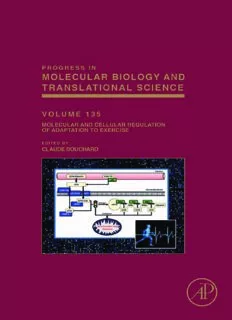
Molecular and Cellular Regulation of Adaptation to Exercise PDF
Preview Molecular and Cellular Regulation of Adaptation to Exercise
VOLUMEONEHUNDRED ANDTHIRTYFIVE P ROGRESS IN MOLECULAR BIOLOGY AND TRANSLATIONAL SCIENCE Molecular and Cellular Regulation of Adaptation to Exercise This page intentionally left blank VOLUMEONEHUNDRED ANDTHIRTYFIVE P ROGRESS IN MOLECULAR BIOLOGY AND TRANSLATIONAL SCIENCE Molecular and Cellular Regulation of Adaptation to Exercise Edited by CLAUDE BOUCHARD Human Genomics Laboratory, Pennington Biomedical Research Center, Baton Rouge, Louisiana, USA AMSTERDAM (cid:129) BOSTON (cid:129) HEIDELBERG (cid:129) LONDON NEW YORK (cid:129) OXFORD (cid:129) PARIS (cid:129) SAN DIEGO SAN FRANCISCO (cid:129) SINGAPORE (cid:129) SYDNEY (cid:129) TOKYO Academic Press is an imprint of Elsevier AcademicPressisanimprintofElsevier 225WymanStreet,Waltham,MA02451,USA 525BStreet,Suite1800,SanDiego,CA92101-4495,USA TheBoulevard,LangfordLane,Kidlington,OxfordOX51GB,UK 125LondonWall,London,EC2Y5AS,UK Firstedition2015 Copyright©2015ElsevierInc.Allrightsreserved. Nopartofthispublicationmaybereproducedortransmittedinanyformorbyanymeans, electronicormechanical,includingphotocopying,recording,oranyinformationstorageand retrievalsystem,withoutpermissioninwritingfromthepublisher.Detailsonhowtoseek permission,furtherinformationaboutthePublisher’spermissionspoliciesandour arrangementswithorganizationssuchastheCopyrightClearanceCenterandtheCopyright LicensingAgency,canbefoundatourwebsite:www.elsevier.com/permissions. Thisbookandtheindividualcontributionscontainedinitareprotectedundercopyrightby thePublisher(otherthanasmaybenotedherein). Notices Knowledgeandbestpracticeinthisfieldareconstantlychanging.Asnewresearchand experiencebroadenourunderstanding,changesinresearchmethods,professionalpractices, ormedicaltreatmentmaybecomenecessary. Practitionersandresearchersmustalwaysrelyontheirownexperienceandknowledgein evaluatingandusinganyinformation,methods,compounds,orexperimentsdescribed herein.Inusingsuchinformationormethodstheyshouldbemindfuloftheirownsafetyand thesafetyofothers,includingpartiesforwhomtheyhaveaprofessionalresponsibility. Tothefullestextentofthelaw,neitherthePublishernortheauthors,contributors,oreditors, assumeanyliabilityforanyinjuryand/ordamagetopersonsorpropertyasamatterof productsliability,negligenceorotherwise,orfromanyuseoroperationofanymethods, products,instructions,orideascontainedinthematerialherein. ISBN:978-0-12-803991-5 ISSN:1877-1173 ForinformationonallAcademicPresspublications visitourwebsiteatstore.elsevier.com CONTENTS Contributors xiii Preface xix 1.Adaptation to Acute and Regular Exercise: From Reductionist Approaches to Integrative Biology 1 Claude Bouchard 1. Introduction 2 2. SedentaryTime,PhysicalActivity,andFitness 4 3. Reductionism,SystemsBiology,andIntegrativePhysiology 8 4. GenomicandENCODEFacts:AGoldMineforExerciseBiology 10 5. AbouttheContentoftheVolume 12 6. SummaryandConclusions 13 References 13 2.Exercise and Regulation of Carbohydrate Metabolism 17 JoramD.Mul,KristinI.Stanford,MichaelF.Hirshman,andLaurieJ.Goodyear 1. Introduction 18 2. CarbohydrateUtilizationDuringRestandExercise 19 3. MuscleGlycogen 20 4. GlucoseTransport 22 5. ExerciseSignalsRegulatingGlucoseTransport 24 6. IncreasesinInsulinSensitivityforGlucoseTransportAfterExercise 28 7. ExerciseTraining:ImpactonHealthyPeopleandPeoplewith Type2Diabetes 29 Acknowledgments 30 References 30 3.Exercise and Regulation of Lipid Metabolism 39 RobertC. Noland 1. CrossoverConcept 40 2. FatMetabolismDuringExercise 40 3. PostexerciseLipidMetabolism 54 4. DietaryFactorsInfluencingExerciseFatMetabolism 58 5. MolecularProgrammingofLipidMetabolism 62 6. ConcludingRemarks 65 References 66 v vi Contents 4.Exercise and Regulation of Protein Metabolism 75 PhilipJ. Atherton, Bethan E.Phillips, and DanielJ. Wilkinson 1. Introduction 76 2. TheRegulationofProteinMetabolismbyExercise 80 3. SignalTransductionRegulatingMuscleProteinMetabolism ResponsestoExercise 86 4. Conclusions 91 References 92 5.Exercise and the Regulation of Mitochondrial Turnover 99 DavidA.Hood, LiamD. Tryon, AnnaVainshtein, JonathanMemme, ChrisChen,Marion Pauly, MatthewJ. Crilly,and HeatherCarter 1. Introduction 100 2. OverviewofMitochondrialTurnover 101 3. MitochondrialMorphologyandChangeswithTraining 102 4. Exercise-InducedSignaling:ARoleforAMPK 105 5. Exercise-InducedSignaling:ARoleforCa2+ 106 6. Exercise-InducedSignaling:ARoleforp38MAPK 106 7. Exercise-InducedSignaling:ActivationofPGC-1α 107 8. AgingandMuscleMitochondria 108 9. AlternativeExercisePrograms:High-IntensityIntervalTraining 111 10. EffectofTrainingonmtDNAandmtDNADiseases 112 11. ExerciseandTrainingonROSProductionandAntioxidantEnzymes 114 12. ExerciseandtheProteinImportPathway 115 13. EffectofExerciseonMitochondriallyMediatedApoptosis 116 14. AutophagyandMitophagywithExercise 117 15. Conclusions 120 Acknowledgments 121 References 121 6.Endurance Exercise and the Regulation of Skeletal Muscle Metabolism 129 FrankW.Booth,GregoryN.Ruegsegger,RyanG.Toedebusch,andZhenYan 1. Introduction 130 2. MitochondrialBiogenesis 131 3. MitochondrialDynamicsandMaintenance 134 4. Mitophagy 135 5. MultipleTypesofExerciseEnduranceTests 137 6. TypeIFibersAreRelatedtoHumanEndurance 138 Contents vii 7. RegulationofMyosinHeavyChainCompositionbyAerobic EnduranceTypesofExercise 142 8. BloodFlowDuringEnduranceExerciseandItsEffectonMetabolism 143 9. Angiogenesis 144 10. SummaryandConclusions 144 References 145 7.Exercise and the Regulation of Skeletal Muscle Hypertrophy 153 ChrisMcGlory andStuart M. Phillips 1. Introduction 153 2. ResistanceExercisetoEnhanceSkeletalMuscleMass 154 3. HeterogeneityinResponsetoResistanceTraining 156 4. TheInfluenceofSystemicHormones 158 5. TheRoleofthemTORC1 160 6. TranslationalResponsestoResistanceTraining 164 7. TheImpactofAgingandUnloading 166 8. Summary 168 Acknowledgments 168 References 168 8.Exercise and the Regulation of Adipose Tissue Metabolism 175 ThomasTsiloulisand MatthewJ. Watt 1. Introduction 176 2. AdiposeTissueLocalizationandComposition 177 3. AdipocyteMetabolismatRestandDuringExercise 177 4. NeuralandHormonalControlofAdiposeTissueMetabolism DuringExercise 180 5. CellularandMolecularControlofAdiposeTissueMetabolism 184 6. MetabolicandMolecularAdaptationsinAdiposeTissuewith ExerciseTraining 188 7. ConclusionsandFutureDirections 194 References 195 9.Exercise and the Regulation of Hepatic Metabolism 203 ElijahTrefts, AshleyS. Williams,and DavidH.Wasserman 1. LiverResponsetoAcuteExercise 204 2. TheLiverRecyclesCarbonsandDisposesofExcessMetabolites 213 3. TheLiverDetoxifiesbyConvertingExcessNitrogentoUrea 214 4. HepaticAdaptationstoRegularPhysicalActivity 215 viii Contents 5. Summary 218 Acknowledgments 219 References 219 10.Molecular Mechanisms for Exercise Training-Induced Changes in Vascular Structure and Function: Skeletal Muscle, Cardiac Muscle, and the Brain 227 T.Dylan Olver, Brian S.Ferguson,and M. HaroldLaughlin 1. Introduction 228 2. TheSkeletalMuscleVasculatureandExercise 229 3. TheHeartandCoronaryVasculature 237 4. TheBrainandCerebralVasculature 242 5. Summary 247 References 249 11.Exercise and Regulation of Bone and Collagen Tissue Biology 259 MichaelKjaer,Niklas RyeJørgensen, Katja Heinemeier, and S.Peter Magnusson 1. Introduction 260 2. IMCT—TrainingandDetraining 264 3. MyotendinousJunction—TrainingandDetraining 267 4. TendonandLigament 268 5. Cartilage—TrainingandDetraining 275 6. Bone 277 7. Conclusion 283 References 283 12.Exercise and the Regulation of Endocrine Hormones 293 Anthony C.Hackney and AmyR.Lane 1. Introduction 294 2. AcuteExerciseHormoneResponses 295 3. AcuteExercise 300 4. ChronicExercise 301 5. ChronicExerciseandPerformance 302 6. CellularandMolecularAspectsofExerciseEndocrinology 306 7. Conclusions 308 References 309 Contents ix 13.Exercise and Regulation of Adipokine and Myokine Production 313 SvenW.Go€rgens,Kristin Eckardt, Jørgen Jensen, ChristianA. Drevon, andJürgen Eckel 1. Introduction 314 2. SkeletalMuscleastheSourceofMyokinesandAdipo-MyokinesAfterAcute andChronicExercise 316 3. ExerciseandtheProductionofAdipokinesbyAdiposeTissue 324 4. Conclusion 328 Acknowledgments 330 References 330 14.Exercise and the Regulation of Inflammatory Responses 337 JacobAllen, YiSun,and Jeffrey A.Woods 1. ABriefHistoryofInflammationandItsUnderlyingRelationshiptoExercise 338 2. ExerciseandAcuteInflammationinSkeletalMuscle 340 3. TheResolutionofInflammationWithinSkeletalMuscle:ACoordinated InflammatoryResponse 341 4. BeyondtheMuscle:AcuteExerciseandSystemicInflammation 342 5. SummaryofAcuteExerciseandInflammation 345 6. ExerciseTrainingandChronicInflammation 346 7. PotentialMechanismsoftheEffectofExerciseTrainingon Anti-Inflammation 347 8. Summary 349 References 350 15.Exercise and the Regulation of Immune Functions 355 Richard J.Simpson, HawleyKunz, NadiaAgha, andRachel Graff 1. Introduction 356 2. TheEffectsofAcuteExerciseonImmuneCellNumberandComposition 356 3. AcuteExerciseandImmuneFunction 360 4. ChronicExerciseandImmuneFunction 367 5. Summary 375 References 375 16.Exercise Regulation of Cognitive Function and Neuroplasticity in the Healthy and Diseased Brain 381 GilianF. Hamilton and Justin S.Rhodes 1. Introduction 382 2. AnimalModelsofExercise 382
Description: